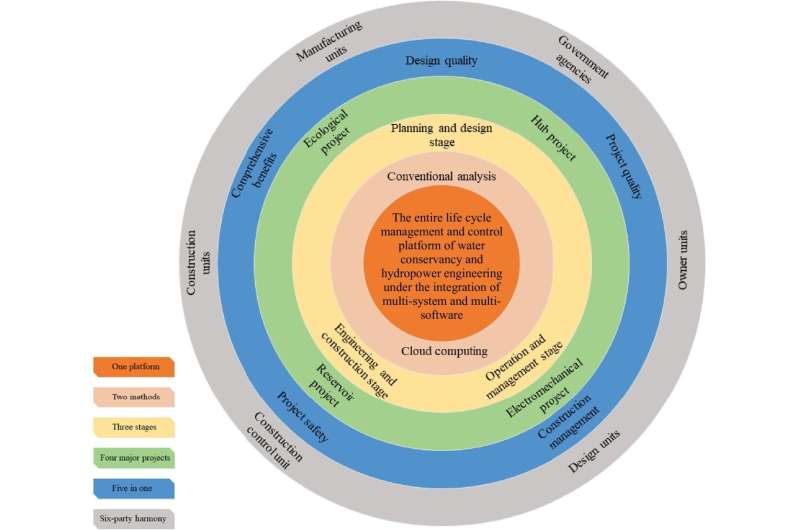This article has been reviewed according to Science X's editorial process and policies. Editors have highlighted the following attributes while ensuring the content's credibility:
fact-checked
proofread
Team develops platform for design of hydropower hub buildings

A research team has developed a platform based on building information modeling (BIM) technology for use in the design of hydropower hub buildings. The platform, called HydroBIM, combines BIM technology with geographic information systems, computer-aided engineering, internet of things, artificial intelligence, and other technologies. The HydroBIM platform provides a comprehensive approach to digital design, intelligent construction, and smart operation of hydropower engineering projects.
The work was published in the Journal of Intelligent Construction on July 31, 2023.
The BIM technology originated in the United States. Over time, it has come to be widely adopted in the water conservancy and hydropower engineering in China. Researchers have extensively studied BIM technology and the ways to be applied in the entire life cycle of water conservancy and hydropower engineering. This research has shown the significant potential in improving the efficiency and quality of engineering design, construction, and operation management in water conservancy and hydropower engineering. In recent years, researchers have explored integrating BIM across various stages of engineering, including the planning and design, construction, and operation management.
This research team proposes a BIM-based system architecture for digital design, intelligent construction, and intelligent operation. Their work also provides a BIM-based multi-professional forward collaborative design method and BIM-based engineering construction management model, along with a real-time safety analysis and evaluation technology system based on actual measured safety information and construction. The last piece of their work was the development of the comprehensive control platform called HydroBIM.
"The HydroBIM system architecture provides an integrated management and control scheme for hydropower engineering planning and design, engineering construction, and operation management. It enables the management and control of water conservancy and hydropower engineering throughout the entire life cycle under the integration of multi-system and multi-software," says Lei Yan from PowerChina Kunming Engineering Corporation.
The HydroBIM series platform has been successfully implemented in over 20 water conservancy and hydropower engineering projects in China, Laos, and Indonesia. Some of these projects include the Nuozhadu Dam, Huangdeng Dam, Hongshiyan barrier lake, Dianzhong Water Diversion Project, and the Kluet-1 hydro power project. Using the HydroBIM platform, the efficiency of design and analysis for water conservancy and hydropower hub buildings has been improved by 1.5 to 2 times in terms of time, compared to conventional methods.
The team summarizes the HydroBIM system as "one platform, two methods, three stages, four major engineering, five in one, and six party harmony." The one platform is an entire life cycle management and control platform of water conservancy and hydropower engineering with multi-system and multi-software integration. Their two methods include conventional analysis and cloud computing. The three stages include the planning and design stage, the engineering and construction stage, and the operation and management stage.
The four major engineering parts include the hub project, the electromechanical project, the reservoir project, and the ecological project. The five-in-one elements include design quality, project quality, construction management, project safety, and comprehensive benefits. The last part is the six-party harmony. This includes government agencies, owner units, design units, construction control units, construction units, and manufacturing units.
The team built the HydroBIM system framework to cover the entire life cycle of water conservancy and hydropower engineering, allowing for complete and interdisciplinary collaborative digital design during the planning and design stage. The engineering construction management stage provides full information management and control of contracts, progress, quality, safety, and investment.
In the operation management stage, the system provides integrated management of engineering safety evaluation, early warning, and emergency planning through monitoring data and consistent guidelines for positive and negative evaluations. The HydroBIM platform also allows for the integration of multi-dimensional BIM information throughout the entire engineering life cycle.
The team's results show that the HydroBIM platform can significantly improve cooperation between participants, work efficiency, and information integration, while ensuring the quality and safety of the life cycle of hydropower engineering. Additionally, the potential of emerging technologies such as artificial intelligence, knowledge graphs, digital twins, virtual reality, blockchain, meta-universe, and others that could be explored in the further to continuously improve the working mode of the water conservancy industry and improve its efficiency.
"Overall, the HydroBIM platform represents a promising approach to the digital transformation of hydropower engineering and has significant potential for future development and application," said Yan.
More information: Zongliang Zhang et al, HydroBIM—Digital design, intelligent construction, and smart operation, Journal of Intelligent Construction (2023). DOI: 10.26599/JIC.2023.9180014

















